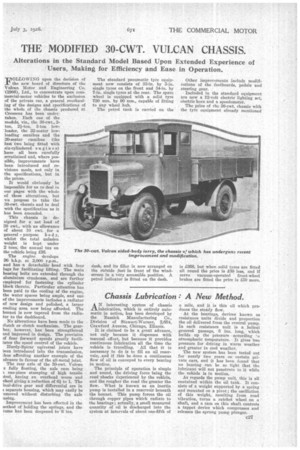THE MODIFIED 30-CWT. VULCAN CHASSIS.
Page 49

If you've noticed an error in this article please click here to report it so we can fix it.
Alterations in the Standard Model Based Upon Extended Experience of Users, Making for Efficiency and Ease in Operation.
FOLLOWING upon the decision of the new board of directors of the Vulcan Motor and Engineering Co. (1906), Ltd., to concentrate upon commercial-motor vehicles to the exclusion of the private car, a general overhauling of the designs and specifications of the whole of the chassis produced at Crossens has been undertaken. Each one of the models, viz., the 30-cwt., 2ton, 2i-ton, 3-ton lowloader, the 32-seater low. loading omnibus and the 20-seater omnibus (the last two being fitted with six-cylinclered engine s) have all been carefully scrutinized and, where possible, improvements have been introduced and revisions made, not only in the specifications, but in the prices.
It would obviously be Impossible for ns to deal in our pages with the whole of these alterations, but we propose to take the 30-cwt. chassis and to deal with the specification as it has been amended.
This chassis is designed for a net load of 30 cwt., with an allowance of about 10 cwt. for a general purpose b o ii y, whilst the total unladen weight is kept under 2 tons, the annual tax on the vehicle being £26.
The engine develops 36 b.h.p. at 2,000 r.p.ta., and has a detachablehead with four lugs for facilitating lifting. The main bearing bolts are extended through the aluminium crankcase, and are further employed for fastening the cylinder block thereto. Particular attention has been paid to the cooling of the engine, the water spaces being ample, and one of the improvements includes a radiator of new design and polished, a larger cooling area now being afforded. The bonnet is now tapered from the radiator to the dashboard.
No alterations have been made to the clutch or clutch mechanism. The gear box, however, has been strengthened and improved in design. The provision of four forward speeds greatly facilitates the speed control of the vehicle.
Hardy-Spicer mitiversal joints have Oeen introduced into the transmission, thus affording another example of the ulvance in favour of the all-metal joint.
The rear axle of the 30-cwt. Vulcan
fully floating, the axle case being tone-piece stamping of high tensile iteel, having an overhead worm and vheel giving a reduction of 64 to 1. The inal-drive gear and differential are in t separate housing, which may easily he .emoved without disturbing the axle .asing.
Improvement has been effected in the uethod of holding the springs and the rams has been deepened to springs, and The standard pneumatic tyre equipment now consists of 33-in. by 5-in. single tyres on the front and 34-in. by 7-in, single tyres at the rear. The spare wheel is equipped with a solid tyre 720 mm. by 90 mm., capable of fitting to any wheel hub.
The petrol tank is carried on the dash, and its filler is now arranged on the outside jUst in front of the windscreen in a very accessible position. A petrol indicator is fitted on the dash. Other improvements include modifications of the footboards, pedals and steering gear.
Included in the standard equipment are now a 12-volt electric lighting set, electric horn and a speedometer, Theprice of the 30-cwt. chassis with the tyre equipment already mentioned is £388, but when solid tyres are fitted all round the price is £30 less, and if servo vacuum-operated front-wheel brakes are fitted the price is £50 more,












































































































